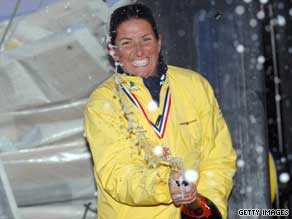
British solo round-the-world sailor Dee Caffari happily admits that you need to be a little bit ‘mad’ to take on long-distance sailing.
And she should know: Caffari became the first woman to sail single-handedly around the world in both directions after completing the solo round-the-world race, Vendee Globe, earlier this year. “People say you must be mad — and there probably is an element of truth in that,” the 36 year-old told CNN. Growing up on the south coast of England, Caffari was bitten by the sailing bug early and her passion for the sport led her to enter the Vendee Globe, considered by some to be the most punishing sporting event on the planet. Caffari spent 99 days at sea completely alone and says preparation is the key to success in long-distance voyages at sea. That, and the desire and self-belief to make it to the finish. “You have to have this desire to see how far you can push yourself. It’s having the willingness to put yourself in that uncomfortable position — and belief that you have the strength to get through it.
MainSail special
Discover incredible super-yachts and get your sailing fix!
Go to MainSail homepage »
“It’s a perceived risk and you go out there knowing that you have done all you can to deal with all scenarios. You don’t just go out there on a whim — we are well trained,” she said. Coping day-to-day during the journey is a whole new challenge: solo sailors must battle perilous conditions, changes to sleep patterns and, inevitably, loneliness. Would you survive a round the world voyage Take our personality test and find out! Caffari says she found being separated from family and friends was the hardest aspect of sailing round-the-world the first time. “The toughest thing about my first journey was not seeing people for six months. You can communicate very well now, perhaps too well, but it still doesn’t allow you to have face-to-face contact with people.” Modern-day communications allow sailors to keep in touch via satellite phones and also keep in Internet contact. Sailors are tracked by global positioning systems (GPS) and also receive regular weather information. “Transition” periods at the start or just after the end of voyages — when sailors are adjusting to boat routines or getting reacquainting with daily life — are also very challenging. Exhaustion while getting used to different sleep patterns was particularly difficult: On board, Caffari would generally sleep in short bursts of two or three hours depending on conditions. The amount of sleep could vary greatly from day-to-day. “The transitions are difficult. Life on board is very disciplined. Your adjustment with new sleeping patterns takes about two to three weeks. If it’s changeable weather when you’re out there, you don’t stand a hope of getting sleep. “It’s a major shock to the body when you get back too. Suddenly you are supposed to get all your sleep at once — and you actually have a night and a day,” she said. Food is also an issue for sailors spending a long time at sea. It needs to keep for a long time and take up minimal space, which means meals can be monotonous — freeze-dried pasta or rice-based dishes made by adding hot water. Cravings are not unusual, according to Caffari. “Thankfully the product has improved. I just get bored of eating the same type of food. You are aware you haven’t had fresh produce in a long time and you start to crave it.” Despite the hardships, Caffari says there are numerous benefits. “It’s an amazing environment. Every time you go out you are going to see something different — but you can’t always prepare for how hostile the environment may be. “I’m not a gadget person, so I quite enjoy the basics of life. I really value my time now. And in a team scenario it can be particularly rewarding, as the ability to not only push one’s own limits but also to push other people’s limits is important,” she said.
The intrepid Caffari is ready to push her limits once again — this time sailing around Britain and Ireland. To find out more about Dee Caffari’s voyage around Britain and Ireland go to her Web site: www.deecaffari.co.uk